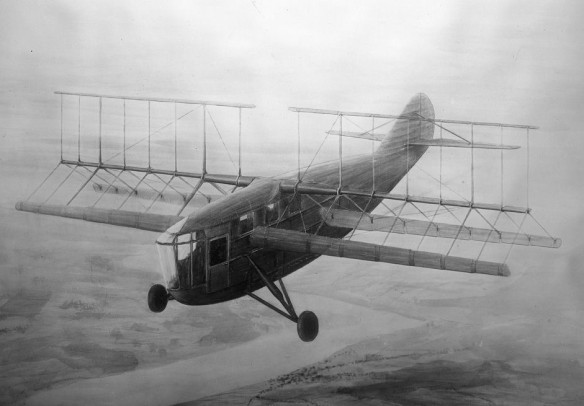
ROHRBACH CYCLOGYRO (1933)
Circular wing aircraft design looked outwardly more straightforward than the Feuerball project, but while the advantages of circular-winged flight were clear – they included vertical take-off and aerodynamic efficiency – ultimate success was tantalizingly just out of reach. Alexander Lippisch was one of the engineers who took up the challenge and from 1941 onwards he worked on circular wing experiments for Messerschmitt, subjecting his design to wind tunnel testing at Göttingen. He later worked on a Drehflügel (rotating wing), which was tested at Peenemünde. However, these projects, which were at the cutting edge of aeronautical research, were still not fully developed by the time the war ended.
The origin of the rotocycloid propeller are Russian and relates to the aeronautic domain. Sverchkov’s “Samoljot” (St. Petersburg, 1909) or “wheel orthopter” was the first vehicle expressly thought to have used this type of propulsion. Its scheme came near to cyclogiro, but it’s difficult to classify it precisely. It had three flat surfaces and a rudder; the rear edge of one of surfaces could be bent, replacing the action of an elevator. Lift and thrust had to be created by paddle wheels consisting of 12 blades, established in pairs under a 120° angle. The blades of a concave shape were changing an angle of incidence by the means of eccentrics and springs. In a bottom of the craft 10 hp engine was arranged. Transmission was ensured by a belt. Empty weight was about 200 kg. “Samoljot” was constructed by the military engineer E.P. Sverchkov with the grants of the Main Engineering Agency in St. Petersburg in 1909, was demonstrated at the Newest Inventions Exhibition and won a medal. Otherwise, it could not pass the preliminary tests without flying.
In 1914, Russian inventor and scientist A.N. Lodygin addressed the Russian government with the project of the cyclogiro-like aircraft, his scheme was similar to Sverchkov’s “Samoljot”. The project was not carried out.
A cyclorotor generates thrust by altering the pitch of the blade as it transits around the rotor.
In 1933, experiments in Germany by Adolf Rohrbach resulted in a paddle-wheel wing arrangement. Oscillating winglets went from positive to negative angles of attack during each revolution to create lift, and their eccentric mounting would, in theory, produce nearly any combination of horizontal and vertical forces. The DVL evaluated Rohrbach’s design, but the foreign aviation journals of the time cast doubt on the soundness of the design which meant that funding for the project could not be raised, even with a latter proposal as a Luftwaffe transport aircraft. There appears to be no evidence that this design was ever built, let alone flown. Based on Rohrbach’s paddle-wheel research, however, Platt in the US designed by 1933 his own independent Cyclogyro. His paddle-wheel wing arrangement was awarded a US patent (which was only one of many similar patents on file), and underwent extensive wind-tunnel testing at MIT in 1927. Despite this, there is no evidence Platt’s aircraft was ever built.
Cyclorotors can quickly vector thrust by altering the pattern of blade pitching.